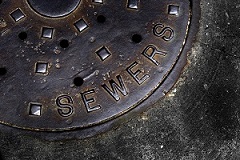Assessing SARS-CoV-2 Virus Levels in Sewage

EPA researchers are building on an expansive body of world-class research by applying that knowledge to reduce the risk of exposure to SARS-CoV-2, the virus that causes COVID-19. Researchers at EPA and the CDC are developing and applying methods for measuring SARS-CoV-2 levels in wastewater. They are developing and applying methods for detecting different forms of the virus, including live, or infectious, virus and the genetic marker of the virus, its RNA, in wastewater and sewage. Standard, reproducible methods of detection are critical to accurately inform public health decisions. This research will focus on developing the best method for detection. Once developed, the methods will be used to determine infectivity, persistence, and treatment efficacies related to SARS-CoV-2 in wastewater.
With an infectious disease like COVID-19, people may be contagious before they show any symptoms. Preliminary research from across the country and around the world indicates that monitoring wastewater for the presence of the genetic marker of SARS-CoV-2, its RNA, may be useful as a sensitive early indicator of low levels of infections in the community. Having an early warning system to alert public health officials about infection, or the lack of infection, could be helpful to direct resources, such as individual testing, to the communities that might need it most. Likewise, monitoring SARS-CoV-2 in wastewater may also provide an indication of decreasing levels of infection within a community.
In addition, while the risk to utility workers is considered low, there is still value in measuring the levels of virus in wastewater to better understand potential risks from exposure to untreated sewage.
Monitoring Virus Levels in Sewage to Assess Community Infection Rate
Preliminary research from across the country and around the world indicates that monitoring wastewater for the presence of the genetic marker of SARS-CoV-2, its RNA, may be useful as a sensitive early indicator of low levels of infections in the community. Having an early warning system to alert public health officials about infection, or the lack of infection, could be helpful to direct resources, such as individual testing, to the communities that might need it most.
EPA researchers, working with Ohio EPA, Ohio Department of Health, and wastewater treatment systems in Southwestern region of the state, are assessing a molecular approach and initiating a monitoring effort to better understand factors affecting the virus in sewage. The results of this research can be found on the Ohio Department of Health COVID-19 Dashboard.
Standardized Methods to Assess Virus in Sewage
The genetic material of the virus that causes COVID-19 has been detected in feces from patients diagnosed with the disease, as well as in raw sewage. EPA researchers, working with researchers at CDC have identified a need for sensitive, standardized methods to detect and quantify SARS-CoV-2 in raw sewage, including infectious virus.
The researchers are developing, evaluating, and applying methods for concentrating and quantifying SARS-CoV-2 with molecular and live, or infectious, assays in wastewater. Once the methods are developed, they will use it to quantify the level of SARS-CoV-2 detected in raw sewage at wastewater treatment plants.
